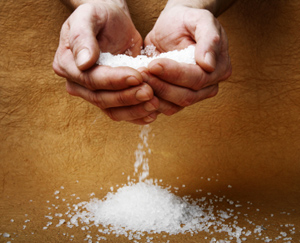Penn Herb Wellness Guide
Salt Is No Friend to Heart or Head

Salty studies
A process called meta-analysis was used to combine and analyze data from 13 previous studies. The advantage of this approach is that it allows for large numbers of people to be studied together, increasing the likelihood that relationships between dietary salt and risk of disease will be discovered, if they exist.
The study revealed that:
- Higher salt diets are linked to higher rates of strokes and cardiovascular events (heart attacks). Even among people with normal blood pressure, higher salt intakes increased disease risk.
- The relationship between salt and risk of strokes and cardiovascular events is dose-dependent: the more salt a person eats, the higher his or her risk of these diseases.
- For a 5-gram per day difference in typical salt intake, there is a 23% increased rate of stroke and a 17% increased rate of cardiovascular events. For example, a group of people eating an average of 10 grams of salt per day will have 23% more cases of stroke and 17% more cardiovascular events compared with a group eating 5 grams of salt per day.
- At the population level, a 5-gram reduction in daily salt intake could lead to 1.25 million fewer deaths from stroke and approximately three million fewer deaths from cardiovascular disease worldwide.
Salt vs. sodium
Salt is made up of sodium and chloride. In the US the recommended dietary allowance (RDA) is given in terms of sodium, not salt. The maximum recommended intake of sodium is 2,300 mg (2.3 grams) per day. For certain groups—those who are 51 and older and those who are African American, or have high blood pressure, diabetes, or chronic kidney disease should consume no more than 1,500 mg (1.5 grams) per day.
To convert grams of sodium into grams of salt, multiply by 2.5. This means 2.3 grams of sodium is the same as 5.8 grams (2.4 x 2.5) of salt.
Average salt intake in the US is 10-12 grams per day. This means most of us need to cut our salt intake in half to reduce our risk of high blood pressure, heart disease, and stroke.
Desalination
To reduce your salt intake:
- Processed food is the single biggest source of salt in the American diet. Particular salt offenders include soup, crackers, chips, bread and baked goods, cereal, sauces and dressings, cold cuts and deli meats, pickled foods, and cured and smoked foods.
- Read labels and avoid foods with more than 230 mg of sodium, or more than 10% of daily intake, per serving.
- Decrease dietary salt slowly over time. As your taste buds adapt, you will be amazed at how salty things you used to eat now taste.
- Remove the shaker from the table to reduce the temptation to salt your food.
- Iodized salt is one of the main sources of dietary iodine in the US, so Americans eating less salt need make sure to get enough iodine from other sources, such as a multivitamin that contains this mineral.
- Cook with less salt.
- Limit salty items such as soy sauce, ketchup, broth, and bullion cubes.
- Always chose “no salt added” when buying canned foods.
(BMJ 2009; Online First Nov 24, 2009)
Copyright 2025 TraceGains, Inc. All rights reserved.


